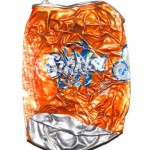
12
2011
- Rolling Rock
- Dr. Pepper
- Sunkist
- Red Stripe
Waste and brands has been common fodder among artists for years. The iconography is recognizable on the surface level forging an immediate connection. Brand colors, type and logos are buried deep in our sub-conscious from childhood. Advertisers and marketeers have marked data to identify impressionable years to the point that if a brand is selected by age seven, it is unlikely the consumer will change. Obviously, we can attribute these decisions to our parents and even grand parents until we are at an age to decide.
We see hundreds of brands a day, in full form in super markets, in our homes, on television and in films. It is unusual to see brands in a distorted or demolished state unless the brand has become waste. It is not the culture of brands to be seen in a state of disrepair.
Documenting found objects did not lend much appeal until I saw three flat cans next to each other in a parking lot in Trenton, NJ. I picked them up and brought them home. The cans waited in a photographers’ developing tray for weeks. I decided to take a few prints off them, inking them up and then pressing the paper onto the form. The results seemed somewhat academic even in multiplicity. On a whim, I decided to photograph a few to see how they would translate. I really liked what I saw. It was simple, pop-like and stark. Some of the cans resembled realist paintings rather than photographs, which raised the visual value to me.
Over the next few months I collected flat cans where ever I would see them. Some I would clean, others I’d leave if I liked how the dirt looked – they were easy to come by once I started looking. Finding the cans became the process in this series, as I would have no way of knowing where I might fine one. It would have to happen to be in the same place I was, in and around city or town street sweeping schedules. I never went in search of the flat cans, I only found them on my travels.
Flat can data became evident when collecting in areas with different socio-economic backgrounds. More often than not I’d find inexpensive beer and red bull cans in Trenton, and seltzer or juice cans in Princeton.
There are automatic comparisons to other artists’ with the ‘Flat Cans’ series. The Pop Art pieces by Andy Warhol, most notably the Campbell’s Soup Can (1962), and ‘Camel Cigarette Pack’ by Irving Penn (1975). It is a popular practice to document or re-contexualize what is culturally current and visible in the immediate environment. I am pleased that ‘Flat Cans’ has become an unintended combination of the two.




